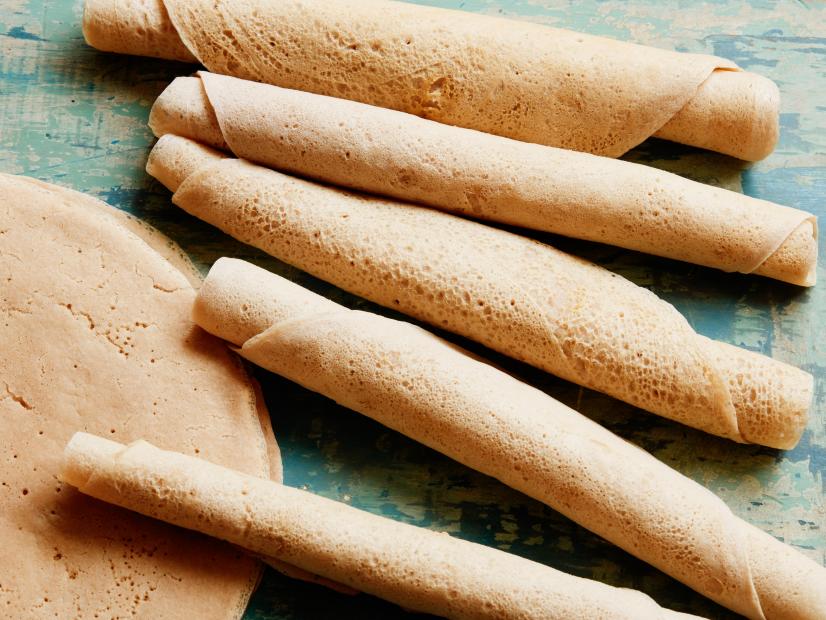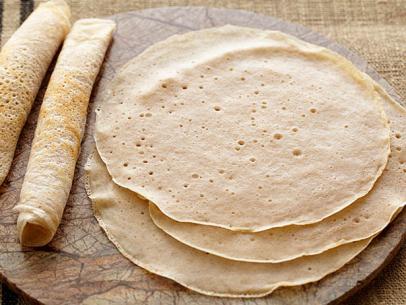
Recipe courtesy of Food Network Kitchen
Recipe courtesy of Food Network Kitchen
Watch how to make this recipe.
Injera
Getting reviews...
- Level: Easy
- Total: 2 days 2 hr (includes fermentation time)
- Active: 1 hr
- Yield: Sixteen 10-inch rounds of injera
-
- Nutritional Analysis
- Per Serving
- Serving Size
- 1 of 16 servings
- Calories
- 116
- Total Fat
- 1 g
- Saturated Fat
- 0 g
- Carbohydrates
- 23 g
- Dietary Fiber
- 2 g
- Sugar
- 0 g
- Protein
- 4 g
- Cholesterol
- 0 mg
- Sodium
- 96 mg
Injera is a sourdough-risen and spongy flatbread that is a staple in Ethiopia. It relies on flour made from teff, which is part of the lovegrass family, and produces seeds as tiny as poppy seeds. It is nutrient-dense and gluten-free. Injera is served with stews, both meat-based and vegetarian; a torn-off piece of the flatbread is used to pick up the accompaniments.
- Level: Easy
- Total: 2 days 2 hr (includes fermentation time)
- Active: 1 hr
- Yield: Sixteen 10-inch rounds of injera
-
- Nutritional Analysis
- Per Serving
- Serving Size
- 1 of 16 servings
- Calories
- 116
- Total Fat
- 1 g
- Saturated Fat
- 0 g
- Carbohydrates
- 23 g
- Dietary Fiber
- 2 g
- Sugar
- 0 g
- Protein
- 4 g
- Cholesterol
- 0 mg
- Sodium
- 96 mg
Ingredients
Directions
- Combine the teff flour and active dry yeast in a large bowl. Add 2 cups lukewarm water and whisk or, more traditionally, use your hand to mix everything together, making sure the mixture is absolutely smooth with no lumps. Cover with plastic wrap and let sit at room temperature until the mixture is bubbly and tastes sour like tangy yogurt, 36 to 48 hours. (It will start bubbling and rising in a matter of hours, but it can take anywhere from 36 to 48 hours to achieve a noticeable level of sourness, which is key to the flavor of the injera; see Cook's Note.) After about 36 hours, begin tasting the mixture; this will help you determine when it's just right and will help prevent it from souring too much.
- At this point, the batter will look separated and watery on top. If you shake the bowl a little, you should see some bubbles rising to the top. Add the self-rising flour and up to 1 cup of water a little at a time. Whisk or use your hand to thoroughly combine into a smooth, thin, pourable mixture with about the consistency of a slightly thicker crepe batter. Cover again and let sit for 1 hour.
- Heat a 10-inch nonstick skillet over medium heat for a few minutes. Have a lid for the skillet and a wire baking rack nearby. Whisk 1 teaspoon salt into the batter (it will bubble up). Pour 1/4 cup of the batter into the skillet, tilting and swirling to coat with a thin layer of batter. The batter should spread quickly and easily. (If it's too thick, whisk in a little more water.) Within a matter of seconds, you should start seeing small holes forming and the surface darkening as it cooks from the outside towards the center. When the injera is about 3/4 of the way cooked, cover the skillet and let steam for 1 minute. The injera is cooked when the edges are dry and lifting up from the pan. Carefully run a spatula underneath and transfer to the baking rack to cool completely. Repeat with the remaining batter.
- You can stack the injera only when they are completely cooled; otherwise, they will stick to each other. Wrap the stack of cooled injera with a dry, clean cloth or paper towels to keep them from drying out until ready to serve. Serve at room temperature, or microwave for 30 seconds to heat through.
Cook’s Note
For a slightly quicker injera, add 1/2 cup plain yogurt to the teff/yeast mixture. Let ferment for 16 hours (instead of 36 to 48 hours), then proceed with the original recipe.

































